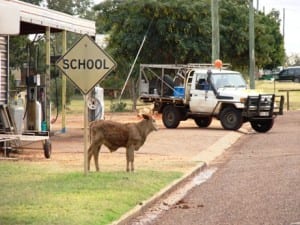Trapped in the desert – part four
By Jack Ashby, on 31 March 2011
A delayed account of zoological fieldwork in Australia – Part 10
From April 2010 I spent about five months undertaking several zoological field projects across Australia. I worked with government agencies, universities and NGOs on conservation and ecology studies ranging from Tasmanian devil facial tumour disease, the effect of fire, rain and introduced predators on desert ecology and how to poison cats. This series of blog posts is a delayed account of my time in the field.
Week Eleven
This week I’ll discuss something interesting and unexpected that happened on our way back out of the desert – some community engagement.
For the past 20 years, Chris Dickman and the Desert Ecology Research Group have been visiting this field site three or four times a year. The last stop before leaving civilisation is a one-street town called Bedourie, the administrative centre of the Shire of Diamantina, which at the last census had a total population of 326. Like nearly all of the settlements around here, the only/main industries here are cattle farming and providing services for those driving the road north that runs through town.
Three or four times a year a convoy of scientists arrive in town for a day on their way to the desert, and then again several weeks later on their way out. Obviously they don’t go un-noticed, but no official interactions have ever occurred between the locals and the scientists. It’s easy to imagine that there might be some animosity between a group that passionately studies biodiversity and natural environments, and people who rely on exploiting those environments for a living, often by introducing the kinds of effects that conservationists try to eliminate. On the other hand, one would guess that both sets of people adore the land and love spending time in it – they are all outdoorspeople.
So for the twentieth anniversary of their studies the team (locally known as “the rat catchers”) arranged a community engagement evening in Bedourie to let them know what they’d been doing. This was done as part of the Iconic Landscapes project I mentioned last week, looking at community/science interactions.
People came to the event from communities hours away, and there was genuine interest in what was happening in their own back yards from the attendants, many of whom wore some of the biggest hats I’ve ever seen. Chris explained the purpose of the study and many of the results (that the biggest effect on mammals and reptile numbers is rain), and everyone nodded along. That foxes are bad for everyone is not controversial. He mentioned the negative correlation between foxes and dingoes (more of one = less of the other) and dingoes is what they all wanted to talk about in the q&a. This is when something strange happened.
I counted four or five opportunities for Chris – an acclaimed ecologist and conservation champion – to say that dingoes had been found to increase biodiversity (which they have), and I’m convinced that was what the crowd was baiting him to say, but each time he pulled up short of saying it. I assumed that he was afraid that this was what they didn’t want to hear, and would dismiss everything else he said as he did. A huge number of farmers poison dingoes – they cover meat in 1080 poison and chuck it off the back of trucks. It looked to me that they wanted him to confirm that dingoes were a good thing – that they wanted a reason to change their baiting practices.
Some of the crowd phrased their questions as if poisoning dingoes were as automatic and unquestionable a practice as giving cattle water, but others said that they knew that having some dingoes (though not enough to pack-hunt) is good for their business. I was disappointed that Chris didn’t take the opportunity to inform the very people who could make a difference here, especially as they seemed to be asking him to.
When I asked him about it in the pub later he said that it was because studies hadn’t been done in all regions yet (including this one) and therefore it might not be true that dingoes are good for biodiversity in southwest Queensland (however there is no evidence to the contrary).
I have to respect the science and truth over conservation politics that he exhibited there, though I’m sure that in his position I would have told them that dingoes HAD been found to benefit. I don’t know many people who would have been so honest.
The event was a real success. Here is a film of what happened by the Iconic Landscapes project:
After a spell in Sydney (where ironically I got a unpleasant spider bite on my first night, having survived a month in the desert unscathed). I headed to the rainforests and reefs of Tropical Queensland.
UPDATE: PART ELEVEN HERE
One Response to “Trapped in the desert – part four”
- 1
 Close
Close




[…] UPDATE: PART TEN HERE […]